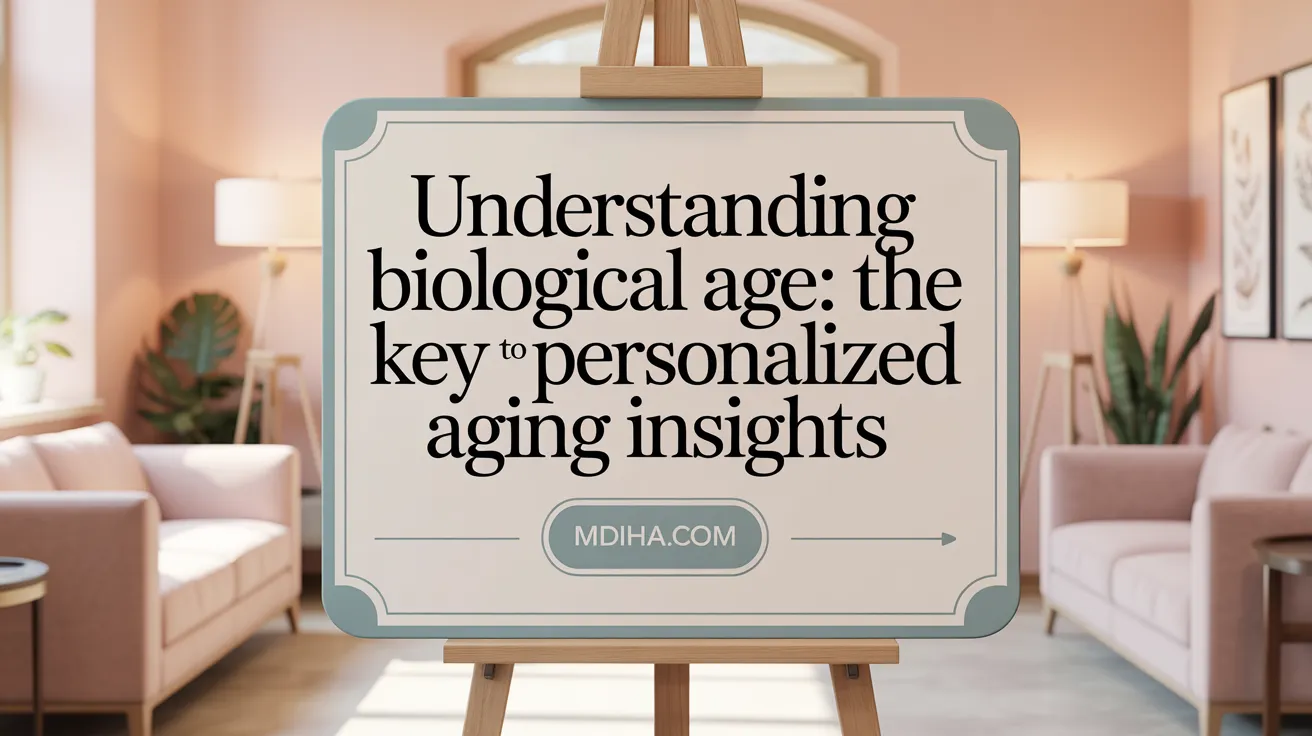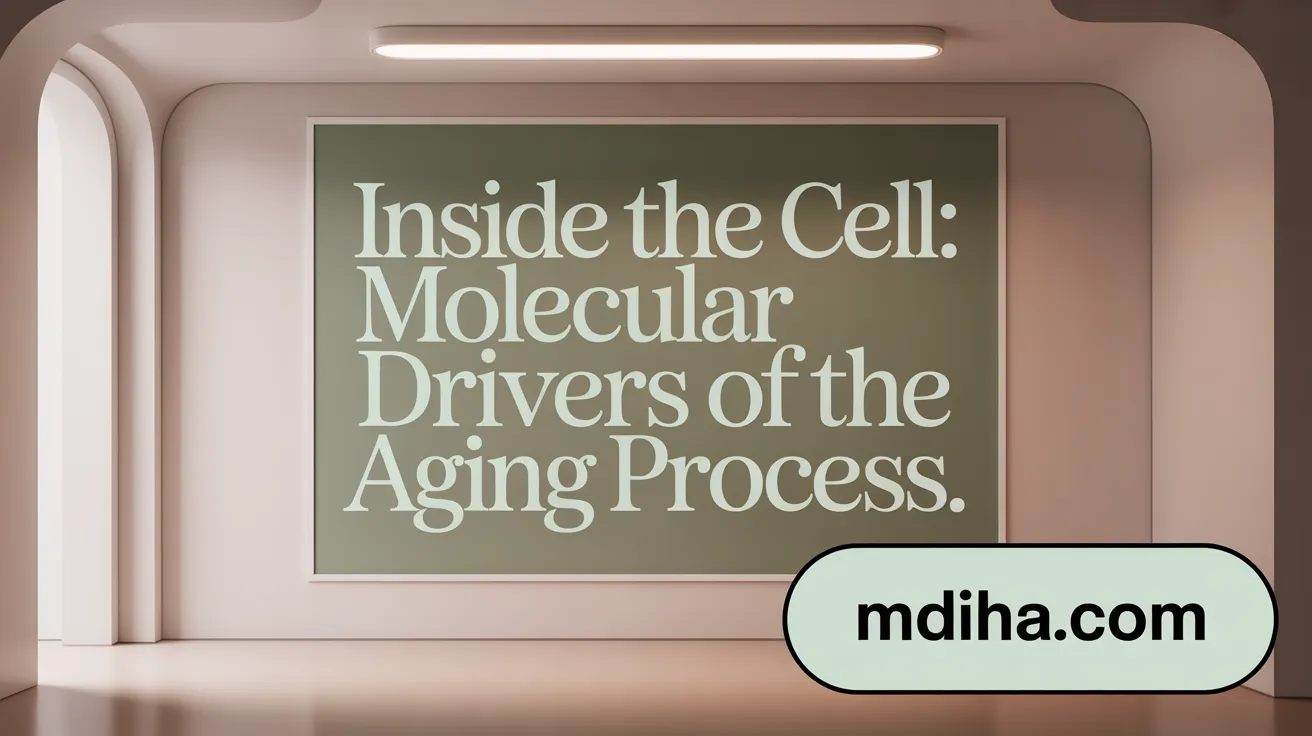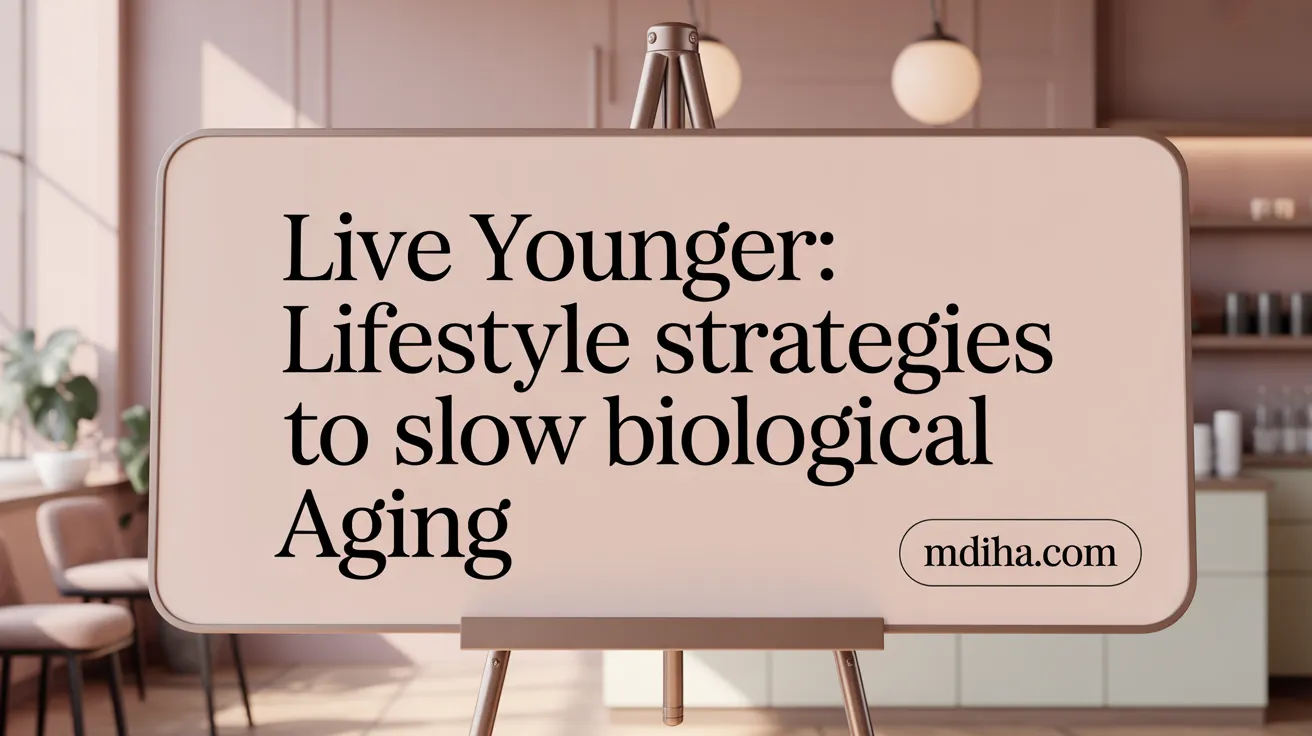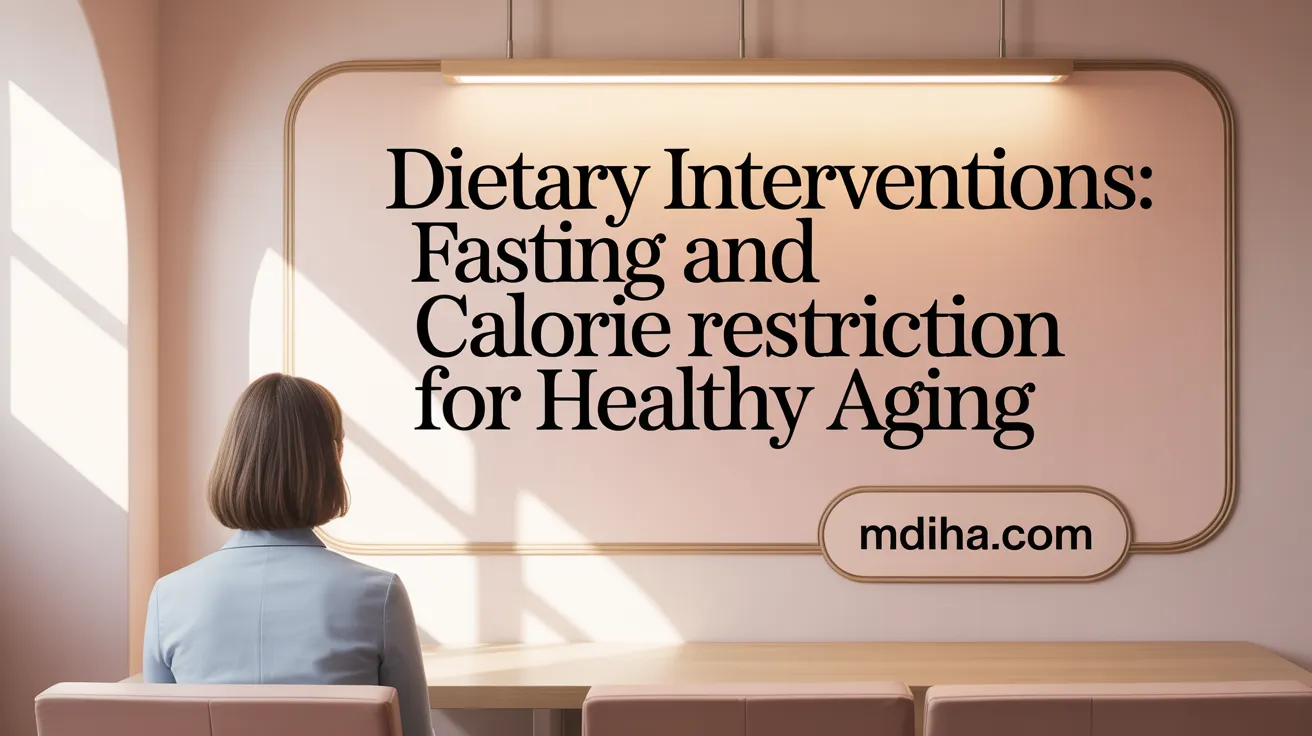Understanding Biological Age and Its Importance
Biological age provides a more accurate reflection of an individual’s physiological state than chronological age. Unlike chronological age, which merely counts the years since birth, biological age measures the cumulative effects of genetics, lifestyle, environment, and cellular processes on the body's systems. Scientists and health professionals are increasingly focusing on biological age because it better predicts health outcomes, disease risks, and lifespan. This article delves into the scientific benefits of reducing biological age, the methods to assess it, and emerging strategies to slow or even reverse aging at the molecular level.
What Is Biological Age and How Does It Differ from Chronological Age?

Definition of biological age
Biological age is a measure of the physiological state and functional ability of an individual's cells, tissues, and organs. Unlike chronological age, which is simply the number of years a person has lived, biological age reflects the accumulated molecular and cellular damage, biological functions, and overall health status. It provides insight into an individual's true aging process and potential risk for age-related diseases.
Difference between chronological age and biological age
Chronological age counts the passage of time since birth, while biological age estimates how old the body's systems appear based on biomarkers and health indicators. For example, two people may both be 50 years old chronologically, but one’s biological age might be younger due to healthy lifestyle and genetics, whereas the other’s could be older due to disease or lifestyle factors. Biological age is a more precise predictor of health outcomes, disease risk, and lifespan than chronological age.
Factors influencing biological age
Several factors affect biological age, including genetics, DNA damage, telomere length, epigenetic changes, inflammation, and lifestyle habits such as diet, exercise, sleep, smoking, and stress. Environmental exposures and social conditions also play a role. Healthy behaviors like regular physical activity, balanced nutrition, smoking avoidance, and good sleep quality can slow biological aging, while poor lifestyle choices accelerate it.
What is the difference between biological age and chronological age?
Biological age reflects the physiological health and functional state of an individual's cells and organs and can differ significantly from chronological age, which simply measures the passage of time since birth. Biological age is influenced by molecular damage, genetics, lifestyle, and environmental factors, whereas chronological age does not account for individual health status or disease risk.
Measuring Biological Age: Biomarkers and Advanced Technologies

How is biological age measured?
Biological age is estimated using a combination of biomarkers that reflect cellular, molecular, and physiological changes associated with aging. These include DNA methylation patterns, telomere length, protein levels, and clinical data from blood and organ function tests.
Biomarkers used in biological age estimation
Common biomarkers include blood biochemical markers like cystatin C and urea nitrogen, anthropometric indices such as body mass index and waist circumference, and clinical parameters including blood pressure. Cognitive and sensory tests and physical performance measurements like grip strength also contribute (source).
Epigenetic clocks and DNA methylation patterns
Epigenetic clocks use DNA methylation data to predict biological age. These clocks analyze specific methylation sites across the genome, providing highly accurate estimates of aging at the molecular level. The DunedinPACE algorithm is one example, estimating the pace of aging from methylation data and linking to health risks.
Telomere length as a biomarker
Telomeres are protective DNA sequences at chromosome ends that shorten with each cell division. Measuring telomere length serves as another aging biomarker, though it is influenced by genetics and environment. Shorter telomeres associate with earlier mortality and age-related diseases (source).
Use of machine learning in biological age assessment
Machine learning and deep learning techniques enhance biological age estimation by integrating complex biomarker data. These advanced algorithms improve prediction accuracy and model aging rates more effectively than traditional methods such as linear regression (source.
Organ-specific biological aging assessment
Since different organs may age at varying rates, measuring organ-specific biomarkers like protein levels in blood allows more precise assessment. This organ-level aging mapping provides deeper insights into overall health and disease risk beyond global biological age estimates (source).
The Role of Molecular and Cellular Mechanisms in Aging

What are the molecular mechanisms underlying biological aging?
Biological aging is driven by a set of intricate molecular and cellular changes that accumulate over time. These changes collectively impair the body's functions and increase vulnerability to diseases. For a comprehensive overview, see molecular mechanisms of aging.
DNA Damage and Genomic Instability
DNA damage gradually accumulates, leading to genomic instability. This impairs cellular functions and disrupts gene regulation, contributing to aging and age-related diseases. More details can be found in DNA damage and genomic instability.
Telomere Attrition and Cellular Senescence
Telomeres are protective caps at chromosome ends that shorten with each cell division. When they become critically short, cells enter senescence—a state of permanent growth arrest that influences tissue aging. This process is closely linked with the DNA damage response and is a key hallmark of aging. For further reading, refer to telomere shortening and cellular senescence and Vitamin D supplements and telomere protection.
Mitochondrial Dysfunction and Energy Decline
Mitochondria, the cell's energy producers, decline in function due to DNA mutations and reduced biogenesis. This leads to lower energy output, increased oxidative stress, and contributes to cellular aging and senescence. See mitochondrial dysfunction and age for additional insights.
Inflammation and Nutrient Sensing
Chronic low-grade inflammation, often termed “inflammaging,” damages tissues over time. Simultaneously, deregulated nutrient sensing pathways, such as those governing metabolism and growth signals, exacerbate age-related decline. Refer to inflammation in aging for more information.
Hallmarks of Aging at the Cellular Level
Other cellular mechanisms include impaired autophagy (the cleanup of damaged cellular components), stem cell exhaustion, loss of protein homeostasis, and altered intercellular communication. Combined, these hallmarks drive the phenotypic characteristics of aging. For an overview of hallmarks and related aging processes, see hallmarks of aging and lifestyle.
Understanding these molecular and cellular drivers offers insight into potential interventions that could slow, prevent, or even reverse aspects of biological aging. For broader perspectives on intervention strategies and biological age measurement, see Can we slow aging?.
Lifestyle Interventions That Can Reduce Biological Age

Which lifestyle factors help slow biological aging?
Lifestyle factors known to slow biological aging include maintaining a balanced, nutrient-rich diet (such as the Mediterranean diet benefits), engaging in regular physical exercise (physical activity and aging, getting adequate quality sleep (sleep and aging), avoiding smoking and excessive alcohol (smoking and health span, managing stress, and fostering positive social relationships. These behaviors promote cellular health, reduce inflammation, protect telomeres (Vitamin D supplements and telomere protection), and support organ function.
Impact of diet on biological aging
A diet rich in fruits, vegetables, nuts, whole grains, and low in added sugars helps slow biological aging by reducing inflammation and oxidative stress (healthy diet and biological age. Mediterranean-style diets and anti-inflammatory nutrient intake correlate with younger biological age measured by epigenetic clocks (Epigenetic clocks and nutrition). Conversely, high added sugar consumption accelerates aging molecular markers.
Physical activity and biological age
Regular exercise preserves muscle mass, improves cardiovascular health, and reduces blood pressure and blood sugar, collectively lowering biological age (physical activity and aging. Active individuals display longer telomeres and slower epigenetic aging (Resistance training and muscle health). Resistance training is particularly effective in delaying declines in muscle and bone health associated with aging.
Sleep quality and aging process
Getting 7-8 hours of good quality sleep enhances brain detoxification and reduces risk for neurodegenerative diseases, potentially slowing brain aging (sleep and aging. Poor sleep is linked to faster biological aging and increased inflammation (Importance of sleep health.
Smoking cessation and toxin avoidance
Avoiding smoking prevents damage to blood vessels, reduces oxidative stress, and lowers biological aging (smoking and health span. Similarly, minimizing exposure to environmental toxins supports cellular integrity and healthier aging (Environmental toxins and biological age).
Stress management and social connections
Managing stress through activities like meditation and maintaining strong social ties reduces chronic inflammation and supports immune function, contributing to healthier biological aging (Yoga, meditation, and lifestyle interventions).
These lifestyle changes create a synergistic effect that can make individuals biologically younger than their chronological age, improving longevity and healthspan (Life's Essential 8 checklist.
Calorie Restriction and Fasting-Mimicking Diets: Scientific Evidence

How do calorie restriction and fasting-mimicking diets impact biological aging?
Calorie restriction, defined as reducing calorie intake without malnutrition, has been extensively studied in animals, showing significant lifespan extension and delayed onset of age-related diseases. These benefits translate into humans, where the CALERIE study—a well-known clinical trial—demonstrated that calorie restriction slowed biological aging. Participants exhibited improvements in blood biomarkers and enhanced muscle gene expression related to muscle formation, repair, and inflammation, which contribute to healthier aging.
Beyond calorie restriction, fasting-mimicking diets (FMDs) have gained attention as practical dietary interventions. Consisting of periodic five-day cycles of low-calorie, low-protein, high-unsaturated-fat meals, these diets mimic the benefits of fasting without complete food abstinence. Clinical trials report that FMD cycles reduce biological age by about 2.5 years on average.
FMDs also rejuvenate the immune system by increasing the ratio of lymphoid to myeloid immune cells, promoting a more youthful immune profile. Additionally, participants experienced reduced risk factors for diabetes, decreased abdominal and liver fat, and improvements in metabolic health—all occurring independently of weight loss. This suggests that both calorie restriction and fasting-mimicking diets positively influence biological aging and may offer accessible strategies to reduce disease risks and promote healthy longevity.
Emerging Therapeutics and Supplements for Biological Age Reduction
Are there supplements or drugs that reduce biological age?
Emerging evidence suggests some supplements and drugs can modestly reduce biological age. One natural supplement, the Cel System, was tested in a year-long clinical trial involving adults aged 54 to 84. Results showed improvements in muscle strength, body composition, and molecular changes related to DNA methylation, stress response, and immune function. While promising, these findings come from an uncontrolled pilot study, indicating a need for further research.
Omega-3 fatty acids and vitamin D supplements have also been studied for their effect on biological aging. A large European trial (DO-HEALTH) found that omega-3 supplementation alone slowed biological aging, measured by DNA methylation clocks, and combining omega-3 with vitamin D and exercise had additive benefits. These interventions produced a biological age reduction equivalent to about 3 months over three years among generally healthy older adults.
At the drug level, compounds such as metformin and senolytics are under investigation for their potential anti-aging effects. Metformin, widely used for diabetes, has entered clinical trials targeting aging pathways, aiming to extend healthspan by improving metabolic and cellular function. Senolytics work by clearing senescent cells, which accumulate with age and contribute to inflammation and tissue decline. Ongoing research hopes to confirm their efficacy and safety for wider application.
Together, these natural supplements and pharmaceuticals represent a growing frontier in therapies aimed at slowing or reversing biological aging, leveraging molecular mechanisms like DNA methylation and immune modulation to improve health outcomes. For more on the biology of aging and interventions, see The Biology of Aging and Can We Slow Aging?.
Blood Factors and Experimental Therapies Targeting Aging
What is the significance of young blood factors in aging research?
Recent research highlights the remarkable potential of young blood plasma in aging studies. Scientists have discovered that certain proteins present in the blood of young animals, such as the protein TIMP2 and brain aging, can reverse aspects of brain aging in older animals.
Reversal of brain aging in animal models
Experiments involving mice have shown that infusion of plasma derived from young donors increases hippocampal plasticity—an essential process for learning and memory. TIMP2 protein, in particular, was identified as a key factor capable of enhancing cognitive functions and neural regeneration in aged mice.
Potential applications in neurodegeneration and cognitive decline
These groundbreaking findings hold promise for future therapeutic strategies to combat neurodegeneration treatments and age-related cognitive decline in humans. While the research is still early-stage and primarily conducted on animal models, the hope is that identifying and harnessing such blood factors could eventually lead to treatments that rejuvenate aging brain tissue and improve cognitive health in elderly populations.
The Impact of Cardiovascular Health and Lifestyle on Biological Aging
How does cardiovascular health influence biological age?
Good cardiovascular health plays a crucial role in slowing biological aging. As measured by the American Heart Association’s Life’s Essential 8 checklist—which evaluates diet, physical activity, nicotine exposure, sleep quality, body mass index (BMI), cholesterol, blood sugar, and blood pressure—individuals with optimal cardiovascular health have been found to have a biological age approximately six years younger than their actual chronological age.
What does Life’s Essential 8 include?
The Life’s Essential 8 checklist comprises the following components:
- Diet quality
- Regular physical activity
- Avoidance of nicotine
- Healthy sleep habits
- Maintaining healthy BMI
- Controlling cholesterol levels
- Regulating blood sugar
- Managing blood pressure
How do lifestyle changes benefit biological aging?
Healthy lifestyle habits such as quitting smoking, eating a balanced diet rich in fruits and vegetables, and exercising regularly help improve cardiovascular health. Smoking cessation reduces blood pressure and prevents vascular damage, while balanced nutrition and physical activity aid in controlling blood sugar, cholesterol, and BMI.
What effects does improved cardiovascular health have on the body?
Improved cardiovascular health enhances endothelial function—the performance of the inner lining of blood vessels—which leads to better blood flow and supports organ health including the kidneys, brain, and muscles. This systemic health boost helps reduce biological age by minimizing damage caused by factors like inflammation and oxidative stress, thus lowering the risk of chronic age-related conditions.
Adopting and maintaining good cardiovascular health through the Life’s Essential 8 is a practical and effective way to decrease biological aging and promote longevity.
Technological Advances in Biological Age Assessment and Their Implications
What role do new technologies play in assessing biological age?
Recent technological advances have revolutionized the assessment of biological age, moving beyond traditional chronological measures. Among the most promising tools are epigenetic clocks such as Horvath’s clock and the DunedinPACE algorithm. These clocks analyze DNA methylation patterns—a form of epigenetic modification—in blood or saliva samples, providing a precise measure of biological age and the pace of aging.
Machine learning techniques underpin these epigenetic clocks, enabling them to handle complex patterns in large molecular datasets and improve predictive accuracy. For example, DunedinPACE integrates methylation data through advanced algorithms to estimate an individual's aging rate, correlating strongly with the risk of chronic diseases and mortality. Such technologies support more personalized medicine by tailoring interventions based on a person’s biological rather than chronological age (biological age versus chronological age).
In clinical settings, these tools may enhance risk stratification, guide preventive care, and monitor responses to anti-aging therapies. However, despite their potential, epigenetic clock tests are not yet fully integrated into routine healthcare due to evaluation, interpretation challenges, and limited regulatory approval.
Ethical considerations also arise, especially concerning the use of biological age for legal or insurance purposes. Determining policies around biological versus chronological age will require careful societal and regulatory discussion (legal age and biological age ethical issues).
In summary, new technologies leveraging epigenetics and machine learning offer a powerful means to assess aging in humans, promising improvements in healthcare personalization while presenting scientific and ethical challenges to be addressed.
Long-Term Benefits and Future Directions in Biological Age Reduction Science
What are the long-term benefits of reducing biological age?
Reducing biological age offers promising long-term benefits including extension of healthspan—the period of life spent in good health. Slowing biological aging delays the onset of various age-related diseases like cardiovascular disease, diabetes, cancer, and neurodegenerative disorders. This leads to improved quality of life and reduced healthcare burdens.
How can integrated lifestyle and therapeutic approaches influence aging?
A combination of lifestyle changes such as a balanced diet, regular exercise, sleep optimization, and stress management alongside emerging therapies like calorie restriction, supplements (e.g., omega-3, vitamin D), and senolytics can synergistically improve cellular and organ function. This integrated approach targets multiple aging mechanisms at molecular and systemic levels, enhancing resilience and functional capacity (Life's Essential 8 for cardiovascular health, Vitamin D and omega-3 effects, calorie restriction and lifespan.
What are the implications for preventing age-related diseases?
By reducing biological age, interventions can prevent or delay diseases linked with aging. For example, improved endothelial function from lifestyle changes lowers cardiovascular risk, while therapies targeting inflammation and cellular senescence may prevent neurodegeneration and cancer. Slowing aging biology fundamentally shifts healthcare from treating diseases to preventing them (Biological age and chronic diseases).
What are the future research priorities and clinical trials?
Future research includes testing novel drugs like metformin and rapamycin, further refining biological age markers, and validating therapies in diverse populations. Clinical trials focus on combining lifestyle and pharmacologic interventions, measuring effects on biological age via epigenetic clocks and functional outcomes. Advances in AI and systems biology will improve personalized aging assessments and enable targeted therapies (machine learning for aging analysis, AI and biological age prediction).
These efforts together aim to translate biological age science into practical, accessible interventions that extend healthy lifespan and reduce age-related morbidity globally.
Harnessing the Power of Biological Age Reduction
Reducing biological age is a promising avenue to extend healthy lifespan and mitigate age-related diseases by targeting fundamental aging mechanisms at the molecular and cellular levels. Advances in biomarker assessment, dietary and lifestyle interventions, and emerging therapeutics offer practical tools and hope for slowing or partially reversing the aging process. As scientific understanding deepens, integrating these insights into personalized healthcare will be key to unlocking the full benefits of biological age reduction, enhancing quality of life for aging populations worldwide.
